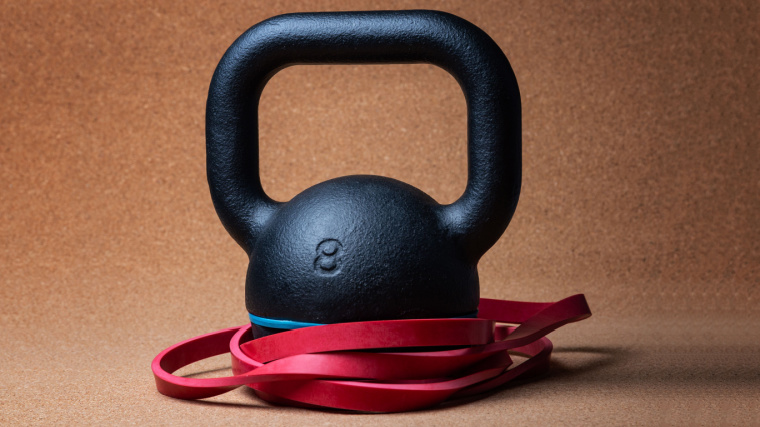Resistance bands catch a bad rap. Most dedicated gym rats think of exercise bands as remedial, low-level tools meant mostly for rank beginners, the elderly, or people with injuries. After all, most physical therapy clinics are lined wall-to-wall with colorful bands and there’s nary a barbell to be found.
While that reputation is at least partially true — you can’t do resistance band biceps curls and wake up the next morning with biceps that Schwarzenegger would blush at — resistance bands have a bit more going for them than you might think.

In some cases, they may even be the optimal tool for the job. A good resistance band workout can accomplish things you simply can’t get from a set of dumbbells. Here’s what you need to know about the differences between free weights vs. resistance bands:
- Free Weights vs. Resistance Bands
- Pros of Free Weights
- Pros of Resistance Bands
- Potential Cons of Free Weights
- Potential Cons of Resistance Bands
- Your Takeaways
- Frequently Asked Questions
Free Weights vs. Resistance Bands
Before you dive in, know first that free weights and resistance bands are hardly polar opposites. They aren’t separate types of exercise; they are types of equipment used to perform resistance training. They’re a tool, not a method.
Key Similarities
- Both free weights and resistance bands apply tension and resistance to your muscles.
- Both free weights and resistance bands can be found in most commercial gyms.
- Free weights and resistance bands both come with varying levels of difficulty.
- Free weights and resistance bands both allow you to work nearly every muscle group in your body.
Key Differences
- The force applied to your body from a free weight is consistent. A 10-pound dumbbell always weighs 10 pounds.
- Resistance bands offer what’s called dynamic resistance, where the amount of challenge changes as you move through your range of motion.
- Free weights are more commonly used for bodybuilding and strength training, since you can work with more challenging levels of resistance by adding additional weight.
Pros of Free Weights
Free weights are the bread and butter of a serious gymgoer’s routine, for the most part at least. While most gyms or personal training studios have resistance bands available, you’ll often see ample amounts of space dedicated to housing various free weights like dumbbell racks, squat racks, or deadlift platforms.
1. Greater Challenge
Put simply, free weights are indispensable for intermediate to advanced exercisers because the potential challenge is much higher. Most gyms stock dumbbells from five pounds into well over one hundred pounds. Similarly, barbells are made to hold many hundreds of pounds of weight.

[Read More: Best Kettlebells]
This allows for a consistent long-term progression pathway. Free weights are, by design, easy to use as a form of progressive overload. You can gradually add another five or ten pounds of weight to your bar over time and develop your muscular strength or size along the way.
2. Consistent Increase in Load
Physics aside, free weights provide consistent amounts of resistance to your body at all times. While there are certainly drawbacks to this, the main benefit of free weights and their consistency is that you can quickly dial up (or turn down) the difficulty of whatever exercise you’re performing.
If a set of dumbbell bench presses is too difficult with 50-pound dumbbells, grab the 45s instead. This is possible to a degree with resistance bands, but the difference in difficulty between bands is often much larger than a five-pound increment.
3. More Versatile
You can perform most exercises with either free weights or resistance bands to semi-comparable results. However, this isn’t always the case, primarily because of the straightforward nature of free weights.
[Read More: The 10 Best Grip Strengtheners On the Market]
Gravity applies downward force, so as long as you can move a weight up in some fashion, you can make an exercise out of it. But bands are characterized by their elastic resistance. If you can’t stretch the band in alignment with the muscle you’re trying to work, you won’t get a whole lot done.
Best Times To Use Free Weights
The equipment you select for your fitness routine should appropriately match the goals you’re chasing in the gym. If you’re aiming for more muscle and strength, and have access to an assortment of free weights, you should capitalize on that availability.
Free weight movements should make up the “meat and potatoes” of a strength training program due to their well-studied efficacy at improving muscular strength, size, and stability. (1)
How To Use Free Weights
Put simply, free weights are less intuitive than certain other types of exercise equipment. Lifting machines often come with instructions plastered somewhere, and heck, everyone knows what a jump rope is for.
[Read More: What Are Workout Splits and Which Is the Best One?]
On the other hand, free weights have a learning curve. Each barbell or dumbbell exercise you perform has a unique technique, and mastering the form of a barbell back squat often takes more than one attempt.
Your best bet for using free weights is to study what proper form looks like or enlist the supervision of a qualified trainer.
Pros of Resistance Bands
Resistance bands aren’t just for rehabilitation (though they’re quite useful in that context too). They offer a handful of unique benefits that you flat-out can’t find over at the dumbbell rack.
1. Great for Stability
Resistance bands are particularly potent at improving bodily control and general stability. While you pull the band apart during an exercise, you have to apply force in that direction and control your own limbs in the process.
These qualities are supported by scientific evidence as well, which has demonstrated the efficacy of resistance band training for populations in dire need of greater joint stability and control, such as the elderly or those suffering from certain chronic diseases. (2)
2. Approachable for Beginners
The designated free weight area at a public gym is for anyone to use, but it certainly doesn’t always feel that way. Muscled-out regulars — especially those with poor gym etiquette — can make the weight room feel quite intimidating.

[Read More: The 8 Best Knee Sleeves You Can Buy]
If you want to start strengthening your body but aren’t yet up for braving those trenches, resistance bands can serve as a viable alternative. You can perform plenty of beginner-friendly exercises with bands, and you don’t have to worry about handling a heavy weight you may not be ready to tango with.
3. Can Use On the Go
One of the most overlooked and undervalued perks of resistance bands is their portability. Adjustable dumbbells are great space-savers, but you still can’t fit them into a backpack or stow them away in the overhead bin on a long flight.
Bands are much easier to travel with or use on the go if you want to stay in shape or burn some calories during a long vacation. Heck, they’re also much less obtrusive to have in your living room than a whole barbell if you’re in the mood for a quick at-home workout.
Best Times To Use Resistance Bands
Resistance bands have a place in any well-rounded workout routine, but there are a few situations in which they’d become particularly useful. Good opportunities for resistance bands include your pre-lifting warm-up to get some blood pumping, as part of a practitioner-guided rehab protocol for an injury, or if you’re traveling and need to do a workout in your hotel room or at the airport.
How To Use Resistance Bands
You can perform most fundamental movement patterns with bands as well as free weights. Though, admittedly, you may have to get creative about your exercise setup or adjust your technique from time to time.
Having a stable fixture around which to tie one end of a band (think the leg of a large chair or a thin pillar) can open up more options as well. In any case, don’t go thinking that you can’t make use of bands just because they aren’t as “intense” as free weights. Some studies have shown band work to be just as effective as free weights for increasing strength, as long as you use them to their full potential. (3)
Potential Cons of Free Weights
Free weights certainly aren’t the end-all, be-all of strength training. There are certain movements you can’t do with a barbell, after all. Keep these drawbacks in mind when deciding which type of equipment is appropriate for you and your goals.
1. May Require a Spotter
You probably don’t need somebody watching your back for every set of dumbbell curls, but certain free weight exercises can be dangerous if you’re going at it alone — think attempting a new 1-rep max on the bench press or pushing yourself for an AMRAP set.
These are situations where it would benefit you to have a spotter present, something you wouldn’t have to worry about if you were using bands instead.
2. Can Be Intimidating
There’s no getting around it, free weights aren’t for everybody. Sure, you can lift heavy with them, but that isn’t a relevant goal for each person who sets foot in a gym. Even the complicated technique involved with certain barbell exercises might dissuade you from using a bar.

[Read More: The 8 Best Lifting Straps You Can Buy]
Bands are much less intense by comparison and still provide a great workout stimulus. There’s no loud clanging and banging and you won’t risk damaging the floor if you drop a band from overhead. For anyone who wants to get active with resistance training but may be spooked by heavy weights, bands are a stellar alternative.
3. Not Appropriate for All Exercises
Free weights are the bedrock of strength training, but there are certain exercises that you can’t do with them. Namely, movements that involve moving your body laterally against resistance, instead of up and down.
This is where a resistance band shines; take a movement like the resistance band pull-apart. The musculature around your shoulder and upper back is designed to pull your arm outward to the side, called horizontal abduction.
But gravity applies force downward. This makes the standard pull-apart impractical to do with free weights, but optimal to do with a resistance band since the movement of your arm matches the directional resistance of the band.
Potential Cons of Resistance Bands
Bands may be more versatile than you think, but they aren’t appropriate for every situation. Here are a few things to consider before working with resistance bands.
1. Difficult To Progress With
By far the biggest drawback of resistance bands is their “low ceiling” — you can only get so much value out of them before needing to look toward other equipment. Many resistance band exercises require you to really stretch the band out fully (think a banded overhead press where you stand on one end), which isn’t always practical to do in the real world.
Bands only get so thick, and extra-thick resistance bands don’t like to stretch out very much. Once you can bang out dozens of repetitions with a medium to heavy resistance band, the value of those sets drops off somewhat.
2. Can Be Awkward
The inconsistent resistance curve of a band is both an asset and a detriment. It can be great for making the hardest part of an exercise even harder (think squeezing with all your might at the top of a biceps curl as the band is maximally lengthened).

[Read More: The Best Online Workout Programs For Coaching, Cardio, Value, And More]
But this also means certain movements are cumbersome to set up or perform. Setting up for a band-loaded push-up variation is much easier said than done, for example.
Your Takeaways
A well-rounded workout program considers all of the resources available to you. There’s no reason to put all your eggs into one basket, either — resistance bands and free weights both have their place. As with anything, it’s all about context.
- The debate between free weights vs. resistance bands isn’t to determine which one is flatly superior to the other, it’s about understanding the appropriate use cases of each.
- Free weights are ideal for training heavy and working on maximal strength and muscle hypertrophy.
- Resistance bands are appropriate for beginners, working around an injury, or to perform exercise routines on the go when you don’t have access to free weights.
- However, bands lack the overload potential of barbells or dumbbells and may not be suitable for intermediate to advanced trainees.
FAQs
Don’t stretch yourself too thin worrying over resistance bands and free weights. Read up on these common questions and their answers.
What is the difference between free weights and resistance bands?
Both free weights and resistance bands are equipment used for strength training. The key difference is that free weights have a consistent force profile, meaning that a 10-pound weight always weighs 10 pounds.
Elastic bands have dynamic resistance. They start off easy and become harder to move the more they’re stretched out.
What are the benefits of free weights?
Free weights are accessible in almost every gyms and are great for high-intensity training. You can also easily adjust the difficulty of an exercise by grabbing a lighter or heavier weight.
What are some benefits of resistance bands?
One of the biggest benefits of resistance bands are their portability — you can fit them just about anywhere and get a good workout in on the go, when traveling, or in the comfort of your own home.
Research shows that bands are also good for developing bodily control and stability, and can be useful in rehabilitative contexts for that reason.
Which is better for strengthening your muscles?
You can strengthen your body to some degree with either bands or weights. However, if you want to truly develop your strength potential, you’ll have to work with barbells and dumbbells eventually, since these objects allow for much heavier loads to be used.
References
- Aerenhouts D, D’Hondt E. Using Machines or Free Weights for Resistance Training in Novice Males? A Randomized Parallel Trial. Int J Environ Res Public Health. 2020 Oct 26;17(21):7848. doi: 10.3390/ijerph17217848. PMID: 33114782; PMCID: PMC7662789.
- Yeun YR. Effectiveness of resistance exercise using elastic bands on flexibility and balance among the elderly people living in the community: a systematic review and meta-analysis. J Phys Ther Sci. 2017 Sep;29(9):1695-1699. doi: 10.1589/jpts.29.1695. Epub 2017 Sep 15. PMID: 28932015; PMCID: PMC5599848.
- Lopes JSS, Machado AF, Micheletti JK, de Almeida AC, Cavina AP, Pastre CM. Effects of training with elastic resistance versus conventional resistance on muscular strength: A systematic review and meta-analysis. SAGE Open Med. 2019 Feb 19;7:2050312119831116. doi: 10.1177/2050312119831116. Erratum in: SAGE Open Med. 2020 Sep 9;8:2050312120961220. PMID: 30815258; PMCID: PMC6383082.
Featured Image: Morocko / Shutterstock